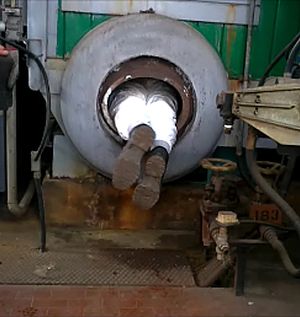KANBrief 4/17

Operatives and technicians must frequently climb into pressure vessels in order to perform construction, maintenance, repair and inspection work. However, the access points through which they must pass for this purpose are often so small that although access is possible, rescuing these personnel in the event of an accident presents considerable difficulties. The Polytechnic University of Milan has conducted a number of studies into this issue in the course of two degree theses.
Around 20,000 shell boilers must be inspected in Germany at intervals of five years. This means that on an average day, 20 technicians are entering a boiler (see also KANBrief 2/13). If the workers involved in manufacture and maintenance of the pressure vessels are added, the number can be assumed to be substantially higher.
Work conducted inside pressure vessels presents a risk of serious accidents, owing for example to the lack of oxygen and the acute exposure to hazardous substances. Rescue measures are difficult under such circumstances, particularly when the affected individual is unconscious, since the access opening on the vessels is normally elliptic in form and has dimensions of only 300 mm × 400 mm or 320 mm × 420 mm. In 2017, we at the Polytechnic University of Milan in the master’s course of Safety and Prevention Engineering in the Process Industry examined the issue of accessing the interiors of fire-tube and water-tube steam boilers. Based upon a hazard analysis and risk assessment, we examined the measures that must be taken before the workers enter the boiler in order for safe working to be ensured. This was necessary since no alternative systems (such as the use of robots) exist at the present time that could fully replace human workers.
By means of studies conducted at the premises of a pressure vessel manufacturer we were able to analyse the work procedures precisely. We examined the influence of a change in position of the manhole or an increase in its cross-section upon the ease of access and exit in the event of an emergency. At the same time, the mechanical stability of the pressure vessel was also considered, since enlargement of the access opening inevitably leads to a drop in the vessel's stability. Various technical measures can be used to compensate for this loss of stability, including an increase in the wall thickness of the vessel or the installation of reinforcing struts.
Also taken into account was the potential need for workers to be rescued from inside the vessel after suffering injury or sudden heart failure. Particular attention was paid here to preventive technical solutions that enable the number of times vessels must be accessed for regular inspections to be reduced (risk-based inspection), and also to particular procedures for rescue personnel that reduce the time required for rescue. The study was also to identify what training should be provided to the rescue personnel, and what personal protective equipment and rescue equipment is suitable for them. Adequate instruction in the use of the equipment is necessary in order to ensure the safety of the personnel working in confined spaces and to prevent (severe) accidents. These aspects are essential for the successful completion of rescue operations during which workers are required to enter pressure vessels.
A further aspect of our studies concerns the physical stress upon the rescue personnel. Several sensors were attached to the body of the rescuer in order to record the heart rate, oxygen saturation and further parameters. Blood samples were also taken before and after the test. This enabled the fatigue and stress experienced by the rescuer during the rescue operations in confined spaces to be measured. The procedure yielded useful information based upon which requirements could in turn be formulated for the physical and performance characteristics of the rescuers deployed in rescue operations in confined spaces.
Plans are for the studies to be extended to further types of pressure vessel, including vessels with internal obstructions (such as agitators). The results are to be used in the development of effective rescue measures. Ideally, they should also be considered during work on the standardization of pressure vessels.
Adriano Paolo Bacchetta
President of EURSAFE (European Interdisciplinary Applied Research Center for Safety),
Associate of SME Safety
presidente@eursafe.eu
Giuseppe Nano
Ivan Belianin
Indrit Dangaj
Milan Polytechnic University